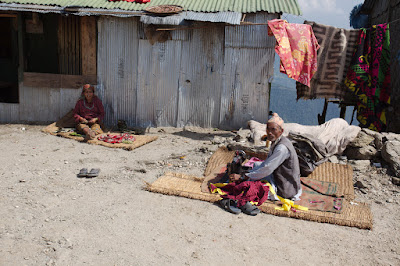In this post I will try address why I chose MAST as the company to organize my trek and what you should expect before you get to Nepal.
I had been wanting to visit Nepal for many years and figured it was a trip worthy of my 40th birthday. It actually took me a couple of extra years to get my act together and actually organize the trip. I had a romantic notion that Nepal would be similar to the Ireland of my youth. Ireland back before we were part of the EU and when the country survived on agriculture and tourism. Ireland back in the time when there was a real sense of community and people really looked out for each other.
Originally the Annapurna circuit was top of my list. It is often cited as one of the top 5 hikes in the world and features in many popular hiking magazines. When I investigated a little more I found that you may have a few hundred people start the Annapurna trek on any given day. The region now has road access and villages have really changed to meet the needs of western tourists. You can find bakeries and coffee shops along the route. This didn’t sound like the Nepal I was looking for.
Everest base camp was a similar story. Base camp itself now has a bakery and internet access. One guide told me there are beds for 1,000 people at Everest base camp and there’s no guarantee you’ll find one empty when you get there. Again this sounded more like a dog and pony show rather than the true Nepal I wanted to see.
A friend found a description of the Makalu Base Camp trek in a trekking guide. There wasn’t much information as not many people visit the region. This sounded much more like the experience we were looking for.
I started researching the Makalu region and found there were really two options for this trek. The first was to do a camping trek with one of the established trekking companies. I found many such companies but their offerings and prices were pretty similar. The second option was to go with Makalu Arun Social Trek (MAST) and do the route as a teahouse trek. Teahouse trekking has only been possible in the last year or two and most people don’t even realize it’s an option. When I realized that going with MAST was a cheaper option than the traditional trekking companies and that about $600 per person was going to fund a local orphanage the decision was easy. I contacted Tejanath and started organizing the trip.
The biggest problem I had with pre-trip preparations was that I really wasn’t sure whether MAST was real or whether I was being duped by a clever internet scam. The communications I received didn’t have the polished look you expect from a tourist serving organization. The same day I booked international tickets and told MAST we were committed to trekking with them I received a mail asking me to send an orphanage fundraiser link to all my friends. I really wasn’t sure whether it was wise to send money to an organization that I honestly had doubts about. I figured it was worth the risk and if it was genuine we would have the trip of a lifetime. If it wasn’t real we could hire guides locally and somehow make the trip happen anyway.
A couple of months before my trip, I was lucky to discover that one of my work colleagues was from Kathmandu. He put me in touch with a family friend who runs a tourism company in Kathmandu. The contact he gave me was Devraj Bajracharya and his company is Mountain Tawache (tawache@mail.com.np). Devraj was able to organize airport pickup and dropoff in Kathmandu, book hotels and take care of foreign exchange. He also organized our TIMS card. I also asked Devraj (via my work colleague) to verify MAST was a genuine organization. As it turns out Devraj comes from Khandbari and knew Tejanath.
If you are interested in trekking with MAST feel free to contact me. I can give you a US number to contact me personally and address and concerns.
One more thing I should address here is the need for evacuation insurance. The Makalu region is very remote with no roads beyond Num (2nd day of trekking). Trails are not built to western standards and the word ‘contouring’ has no meaning in Nepal. This trek is really appropriate for the experienced trekker with a spirit of adventure. It is not uncommon for helicopter evacuations in the region and you really want to protect yourself from the cost of same. I found the insurance on the lonely planet website to be good value (http://www.lonelyplanet.com/travel-insurance/).




























































